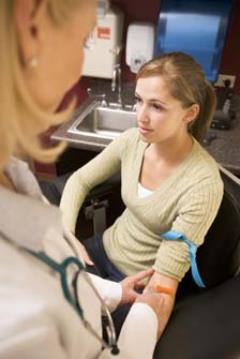The Northeast Medical Institute - New Haven Campus Phlebotomy Course & Cna Class Diaries
The Northeast Medical Institute - New Haven Campus Phlebotomy Course & Cna Class Diaries
Blog Article
How Northeast Medical Institute - New Haven Campus Phlebotomy Course & Cna Class can Save You Time, Stress, and Money.
Table of ContentsThe 5-Minute Rule for Northeast Medical Institute - New Haven Campus Phlebotomy Course & Cna ClassThe Greatest Guide To Northeast Medical Institute - New Haven Campus Phlebotomy Course & Cna ClassThe Greatest Guide To Northeast Medical Institute - New Haven Campus Phlebotomy Course & Cna ClassExcitement About Northeast Medical Institute - New Haven Campus Phlebotomy Course & Cna ClassLittle Known Questions About Northeast Medical Institute - New Haven Campus Phlebotomy Course & Cna Class.Northeast Medical Institute - New Haven Campus Phlebotomy Course & Cna Class Things To Know Before You Buy
The usage of such gadgets ought to be come with by various other infection avoidance and control methods, and training in their use. Not all safety devices apply to phlebotomy. Before picking a safety-engineered tool, individuals ought to thoroughly explore readily available tools to identify their suitable usage, compatibility with existing phlebotomy techniques, and effectiveness in securing personnel and patients (12, 33).For settings with reduced resources, cost is a motoring consider purchase of safety-engineered tools - CNA Training. Where safety-engineered tools are not offered, proficient use a needle and syringe is appropriate. Unexpected direct exposure and certain information regarding an event need to be tape-recorded in a register. Assistance services must be promoted for those who undertake unintentional direct exposure.
One of the crucial pens of quality of care in phlebotomy is the involvement and participation of the person; this is mutually valuable to both the health worker and the client. Clear info either created or spoken need to be available to each patient who undergoes phlebotomy. Annex F offers sample message for explaining the blood-sampling procedure to a client. In the blood-sampling room for an outpatient department or facility, supply a comfy reclining couch with an arm rest.
The smart Trick of Northeast Medical Institute - New Haven Campus Phlebotomy Course & Cna Class That Nobody is Talking About
Guarantee that the signs for blood sampling are clearly defined, either in a created protocol or in recorded instructions (e.g. in a lab form). In any way times, follow the approaches for infection avoidance and control listed in Table 2.2. Infection avoidance and control practices. Gather all the tools needed for the procedure and area it within safe and simple reach on a tray or cart, guaranteeing that all the things are clearly visible.
Where the patient is adult and aware, comply with the actions described listed below. Present on your own to the patient, and ask the client to specify their complete name. Examine that the research laboratory form matches the client's identity (i.e. match the client's details with the lab type, to make certain exact recognition). Ask whether the license has allergies, phobias or has ever passed out during previous injections or blood draws.
Make the patient comfortable in a supine placement (if feasible). Location a clean paper or towel under the client's arm. Talk about the test to be performed (see Annex F) and get spoken approval. The patient has a right to reject an examination at any type of time before the blood tasting, so it is very important to make sure that the patient has actually understood the procedure.
The smart Trick of Northeast Medical Institute - New Haven Campus Phlebotomy Course & Cna Class That Nobody is Talking About
Extend the client's arm and check the antecubital fossa or lower arm. Situate a blood vessel of an excellent dimension that is noticeable, straight and clear.
DO NOT put the needle where veins these details are drawing away, due to the fact that this raises the opportunity of a haematoma. Finding the capillary will assist in figuring out the right size of needle.
Haemolysis, contamination and existence of intravenous fluid and medicine can all modify the outcomes (39. Nursing personnel and physicians may access main venous lines for samplings complying with procedures. However, samplings from main lines lug a danger of contamination or wrong research laboratory test results (https://northeastmed.weebly.com). It is acceptable, however not optimal, to attract blood specimens when initial introducing an in-dwelling venous tool, before attaching the cannula to the intravenous fluids.
Northeast Medical Institute - New Haven Campus Phlebotomy Course & Cna Class - An Overview
Failure to enable adequate call time raises the threat of contamination. DO NOT touch the cleansed website; in specific, DO NOT put a finger over the capillary to direct the shaft of the subjected needle.
Ask the individual to form a hand so the capillaries are a lot more famous. Go into the vein swiftly at a 30 level angle or much less, and continue to present the needle along the blood vessel at the most convenient angle of access - PCT Training. As soon as enough blood has been collected, launch the tourniquet BEFORE withdrawing the needle
All About Northeast Medical Institute - New Haven Campus Phlebotomy Course & Cna Class
Withdraw the needle delicately and apply gentle stress to the site with a tidy gauze or completely dry cotton-wool ball. Ask the individual to hold the gauze or cotton wool in position, with the arm expanded and raised. Ask the individual NOT to flex the arm, since doing so creates a haematoma.

6 Easy Facts About Northeast Medical Institute - New Haven Campus Phlebotomy Course & Cna Class Described
Where feasible, keep the tubes in a rack and relocate the shelf in the direction of you - https://moz.com/community/q/user/northeastmed. If the example tube does not have a rubber stopper, inject exceptionally gradually into the tube as decreasing the pressure and velocity used to transfer the sampling decreases the risk of haemolysis.

Report this page